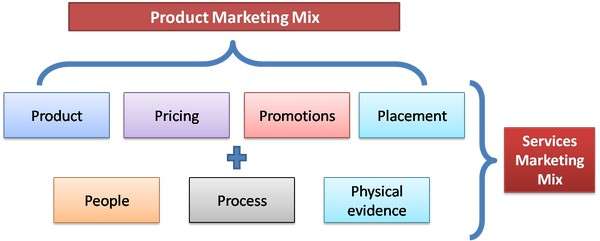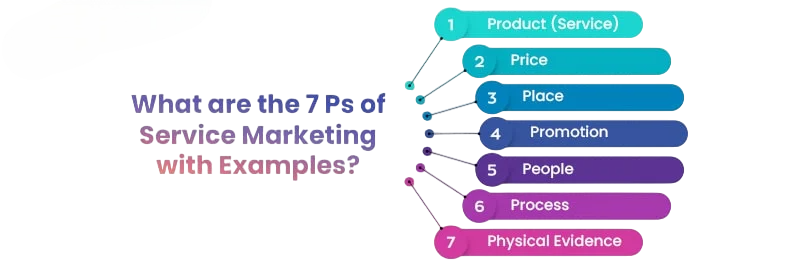
- Introduction to Service Marketing
- Overview of Traditional 4 Ps
- Product in Service Marketing
- Price in Service Marketing
- Place in Service Marketing
- Promotion in Service Marketing
- People in Service Marketing
- Process in Service Marketing
- Physical Evidence
- Importance of 7 Ps
- Application in Real World
- Conclusion
Introduction to Seven Ps of Service Marketing
Service marketing is a distinct branch of marketing that focuses on the promotion, delivery, and management of services as opposed to physical products.The Seven Ps of Service Marketing Services are intangible, and their quality can be more difficult to measure, creating unique challenges for marketers. The goal of The Seven Ps of Service Marketing is to meet customers’ needs while delivering value through experiences and interactions. This type of marketing has become crucial in modern economies, where services often account for a large portion of the GDP. It includes services such as banking, education, healthcare, hospitality, and IT services, among others. The service sector differs from product marketing in various ways, most notably in its intangible nature. Services cannot be touched, seen, or owned, which makes their promotion and delivery more complex. The seven Ps of service marketing must focus on elements such as quality, customer satisfaction, and the delivery process to ensure customers have positive experiences.
Overview of Traditional 4 Ps
Traditionally, marketing has been based on the “4 Ps,” which are:
Product – What is being offered to the market, including both tangible and intangible features. Price– The cost customers pay for the product or service. Place – The channels used to distribute the product or service to customers. Promotion – The tactics used to inform customers about the product or service, such as advertising, sales promotions, and public relations.These 4 Ps were originally developed for physical products, and while they are still relevant, service marketing requires additional factors to be considered. The intangibility, inseparability, variability, and perishability of services necessitate a broader marketing mix.
Product in Service Marketing
In service marketing, the “product” refers to the service offering itself, which could be anything from a hotel stay, a medical procedure, a financial service, or a consulting session. Unlike physical goods, services are intangible, making it harder for customers to evaluate them before consumption. This is where the service marketing 7 Ps framework becomes essential in guiding marketers to manage customer expectations and deliver consistent quality.

By focusing on aspects like product, process, and people from the service marketing 7 Ps, companies can enhance the overall service experience. Service marketers strive to define what the service provides, how it meets customer needs, and how it can be personalized. Leveraging the full scope of the service marketing 7 Ps, they ensure services are designed, delivered, and adapted effectively to meet evolving client preferences and provide lasting value.
Price in Service Marketing
Pricing in service marketing is a complex process, as services often involve a dynamic pricing strategy that may depend on demand, time, and customer characteristics. Unlike tangible products, services do not have a fixed cost associated with production and often vary in price depending on the time of consumption, the level of service provided, or the customer’s relationship with the provider. The pricing strategy for services may include:
- Penetration Pricing: Offering low prices to enter the market and attract customers.
- Skimming Pricing: Charging high prices initially to attract early adopters, then lowering them as the market matures.
- Dynamic Pricing: Prices that change based on real-time factors, like demand, customer behavior, and market conditions.
- Psychological Pricing: Using pricing tactics like “$9.99” instead of “$10” to make the service appear more affordable.
Price is a key element in service marketing as it directly impacts the perceived value of the service. Service marketers need to find a balance between price and quality that aligns with the expectations of their target audience. Competitive pricing strategies and understanding customer perception of value are critical.
Place in Service Marketing
In service marketing, “place” refers to the delivery and distribution of services. Unlike products, which can be stored and distributed through physical channels, services are typically consumed at the point of delivery. The “place” in service marketing often includes both physical and virtual locations where the service is provided, such as a hospital, an online education platform, or a retail store. Service marketers must focus on distribution channels that make the service easily accessible to their target customers. For example:

- Brick-and-mortar locations: Physical stores, offices, or service centers.
- Online platforms: Digital services, mobile apps, and e-commerce websites.
- Hybrid models: A combination of physical and digital service delivery (e.g., booking a hotel online and checking in at the physical location).
The place also involves ensuring that the service environment (or servicescape) aligns with the service being delivered. In hotels, for instance, the physical setting (e.g., décor, cleanliness, comfort) plays a significant role in customer satisfaction.
Promotion in Service Marketing
Promotion in service marketing is critical to communicating the value of a service and differentiating it from competitors. Services are intangible, so promotional activities must focus on building trust, showcasing benefits, and emphasizing customer experiences. Promotional strategies often rely on both traditional and digital media, including advertising, word of mouth, sponsorships, and social media. Effective promotional strategies for services may include:
- Advertising: TV, radio, print, or online ads to create awareness and communicate service benefits.
- Sales Promotion: Special offers, discounts, or loyalty programs to encourage trials or repeat business.
- Public Relations: Building a positive brand image through media coverage, events, and public communication.
- Digital Marketing: Using SEO, content marketing, social media, and email campaigns to promote services and engage with customers.
In service marketing, customer testimonials, case studies, and reviews play a significant role in promotional activities, as potential customers often rely on others’ experiences to make purchasing decisions.
People in Service Marketing
The “people” element in service marketing is perhaps the most significant differentiator from product marketing. Since services are often delivered directly by people, the human element plays a crucial role in shaping customer experiences. The interactions between employees and customers are pivotal to the overall satisfaction of the service. Service employees must possess the skills, attitude, and empathy required to create positive experiences for customers. Training and development are essential in ensuring that employees can deliver excellent service consistently. Additionally, the behavior and appearance of staff, whether they are customer-facing or behind the scenes, contribute to the brand’s image and customer satisfaction.
Process in Service Marketing
Process refers to the procedures, mechanisms, and flow of activities by which the service is provided. This can include everything from the booking process for a flight to the steps involved in receiving medical treatment. The efficiency and consistency of these processes are crucial in ensuring customers receive high-quality service every time. Processes should be designed to:
- Ensure efficiency and speed.
- Maximize customer satisfaction by minimizing errors and ensuring a smooth experience.
- Use technology to streamline operations and improve customer interaction (e.g., mobile check-ins or online banking).
Well-designed processes are essential for maintaining quality, especially in high-volume service businesses like restaurants, airlines, or call centers, where customers’ expectations must be met consistently.
Physical Evidence in Service Marketing
Since services are intangible, physical evidence refers to the tangible elements that help customers evaluate and experience the service. These could include the physical environment where the service is delivered, brochures, websites, logos, business cards, or any other tangible cues that reinforce the service’s quality and brand. For example:
- The decor of a restaurant or hotel communicates its atmosphere and service quality.
- Packaging for services like event tickets or brochures that explain service details.
- Branding and visual elements like logos, which convey professionalism and trust.
Physical evidence gives customers clues about the intangible aspects of the service, making it essential for building credibility and trust.
Importance of the 7 Ps
The seven Ps of the service marketing mix are more complete when People, Process, and Physical Evidence are added to the original four Ps. The 7 Ps of service marketing offer a comprehensive structure that highlights both the service’s experience and its primary product. It emphasizes that human elements (people), the procedures involved, and the physical cues that clients meet are just as important to the delivery and quality of services as the product, pricing, location, and marketing. Businesses may guarantee the following by implementing the 7 Ps of service marketing: 7 Ps of service marketing reliability in the provision of services. Personalized experiences that effectively engage customers. a thorough method for establishing and overseeing client happiness at every touchpoint.
Application in the Real World
In the real world, the 7 Ps of service marketing are applied across industries like hospitality, healthcare, banking, and education. For instance, a hotel applies the 7 Ps by:- Offering a high-quality product (comfortable rooms).
- Setting competitive pricing that matches customer expectations.
- Promoting its services through ads and online reviews.
- Providing friendly, professional staff (people).
- Ensuring smooth check-in/check-out processes (process).
- Creating a welcoming environment (physical evidence).
Similarly, service providers in the healthcare sector, such as clinics, apply the 7 Ps by ensuring qualified staff, seamless booking systems, accessible locations, and clear communication of service benefits.
Conclusion
The Seven Ps of Service Marketing is a multifaceted discipline that goes beyond the traditional 4 Ps of marketing. The introduction of the 3 additional Ps People, Process, and Physical Evidence helps marketers address the unique challenges of marketing intangible services. By focusing on these key elements, businesses can create positive customer experiences, build trust, and differentiate themselves in competitive markets. The 7 Ps provide a comprehensive framework for service marketing, enabling companies to effectively communicate the value of their services, deliver consistent quality, and meet customer needs.





